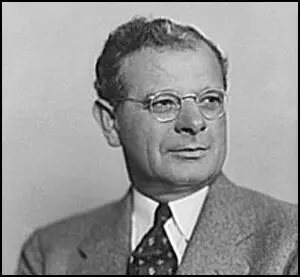Sidney Hillman
Sidney Hillman was born in a Lithuanian village in Russia on 23rd March, 1887. When he was fourteen he was sent to a Jewish seminary. He left after a year and became involved in the trade union movement. Hillman took part in the 1905 Russian Revolution and when this failed he fled the country.
Hillman lived in England for two years before emigrating to the United States in 1907. Hillman settled in Chicago where he found work as a fabric cutter. He joined the union and after he successfully led a strike in 1910 he became an agent for the United Garment Workers of America (UGWA).
In 1914 Hillman agreed to become an official of the International Ladies Garment Workers Union (ILGWU) in New York. Later that year Hillman was appointed as president of the Amalgamated Clothing Workers of America (ACWA). Under Hillman's leadership the ACWA pioneered several important social and economic schemes such as labor banks, unemployment insurance and cooperative housing projects.
In 1936 the American Labor Party (ALP) was formed by left-wing supporters of Franklin D. Roosevelt and the New Deal. This included Sidney Hillman, Abraham Cahan and David Dubinsky. The ALP put forward a left-wing, non-socialist, program. Its 1937 Declaration of Principles stipulated that there should be a "sufficient planned utilization of the natural economy so that coal, oil, timber, water, and other natural resources that belong to the American people... shall be protected from predatory interests." The following year, ALP member, Vito Marcantonio was elected to Congress where he represented East Harlem's 20th District.

In 1938 John Abt became chief counsel to Sidney Hillman. For the next ten years, Abt was Hillman's main political operative within the Congress of Industrial Organizations (CIO). According to Michael Myerson: "He (Apt) first conceived the notion of political action committees (PACs) and established CIO-PAC (for which he also served as chief counsel) to build organized labor's political influence."
Hillman was a member of the Socialist Party but impressed by the policies of Franklin D. Roosevelt when governor of New York, became a supporter of the Democratic Party. In 1933 Roosevelt appointed Hillman as a member of his Labor Advisory Board and during the Second World War was associate director of the Office of Production Management.
Sidney Hillman died of a heart-attack on 10th July, 1946.
Primary Sources
(1) John Gates, The Story of an American Communist (1959)
The labor movement recognized in the NRA a charter for organizing the unorganized: the more forward-looking of the labor leaders like John L. Lewis and Sidney Hillman understood that the great unorganized mass-production industries could be organized only along industrial union lines, although this ran counter to the craft union ideology of the AFL's top officialdom. Lewis, Hillman and others formed a committee inside the AFL to promote industrial unionism. This brought them into open conflict with the top bureaucracy and led to their expulsion and the formation of the Committee of Industrial Organizations, the CIO. For years the Communists had been plugging doggedly and almost alone with their small industrial unions. Now they found their ideas and slogans taken up by powerful forces. With years of experience behind them, with their skeleton union organizations in many industries, and with their widespread contacts, the Communists got in on the ground floor of the burgeoning movement.

